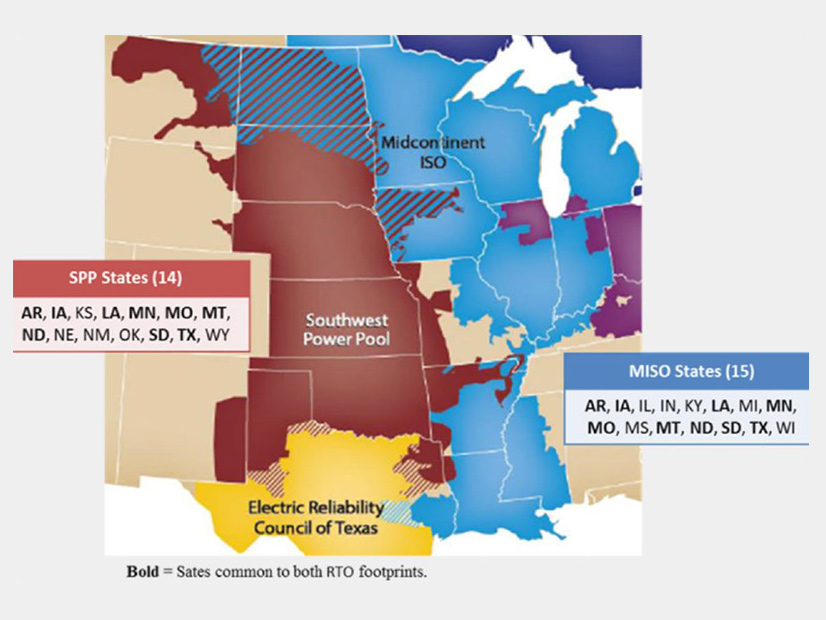MISO and SPP on Monday said two expensive amalgamations of smaller transmission projects have emerged as options to help generation projects interconnect near their seams.
The results are the latest in the RTOs’ joint targeted interconnection queue study, which is searching for interregional transmission projects to alleviate their jampacked generator interconnection queues. (See MISO-SPP Targeted Interconnection Study Moves Forward.)
The first cluster, a $424 million project, incorporates a long distance 345-kV line from Big Stone, S.D., to Alexandria, Minn.; a 345-kV line on the northeast side of Kansas City; and a transmission facility on the west side of Minneapolis.
A second, more expensive alternative to the multipoint project includes an additional segment from Alexandria to Monticello, Minn., bringing the project’s costs to $728 million.
SPP Vice President of Engineering Antoine Lucas cautioned the projects’ reveal is “very preliminary.”
“I just want everyone to keep in mind that these are initial results,” he told stakeholders during a joint SPP-MISO workshop.
While the study shows both projects mitigating nearly 20 constraints, three major flowgate constraints remain untouched on 345-kV lines on the Kansas-Missouri border near Kansas City.
“By using these two projects, we were able to mitigate most of the constraints, except for the top three,” MISO Senior Transmission Planning Engineer Sumit Brar said. MISO and SPP will soon open another window for stakeholder suggestions addressing the three most congested flowgates, Brar said.
The two clusters currently have negative benefit-to-cost ratios because their increased capacity has downstream effects on nearby areas that raise shadow prices.
The RTOs have also come up with nine other project ideas that crisscross the seams in Minnesota and South Dakota and range from $32 million to $1.6 billion. The two also received 18 alternative proposals from stakeholders, costing between $64 million and $871 million and spread from Kansas City to Minneapolis and Sioux City, Iowa.
The grid operators said they evaluated 29 projects submitted by staff and stakeholders, including the two optimized project groupings. Eight projects failed to provide relief on seams constraints when tested.
The RTOs said they then tested six different combinations of the most effective projects, finding two of them solved most of the RTOs’ flowgate constraints.
SPP’s Juliano Freitas said the projects will undergo more testing. Staff are using their respective reliability models and those from the MISO Transmission Expansion Plan and SPP’s Integrated Transmission Planning process to test projects for economic benefits.
Lucas said the RTOs won’t test project candidates for how well they might facilitate the interconnection of individual generation requests. However, he said, projects will be tested for how many hypothetical new projects they could allow on their systems.
“It’s important that we get a sense of how much these projects will advance interconnections, how much and in what areas,” Advanced Power Alliance’s Steve Gaw said.
Stakeholders asked MISO and SPP to create a map showing seams projects under consideration. They also asked why some voltage stability issues that consistently show up in queue studies didn’t show up in the RTOs’ reliability study. Staff planners said their study incorporated interconnecting generation, which might have resolved voltage problems.
SPP CEO Barbara Sugg said the RTOs’ relations over the past 18 months are the best they’ve ever been for study collaboration and coordination during storms.
“The work we’ve been able to do over the past several months has really been astounding,” she said.
Sugg said renewable expansion along the seams will continue to be limited unless the grid operators can find high-value network upgrades that will let more requests reliably interconnect.
SPP currently has approximately 82 GW awaiting interconnection in its queue. MISO’s queue stands at 83 GW with a new round of applications coming in July. MISO planners have said they expect the newcomers to push the queue to the 100-GW-plus highs seen in 2020.
“We’ve not resolved the cost allocation at this point because we wanted to focus on the engineering study,” Sugg said.
The RTOs have scheduled a cost-allocation discussion with stakeholders on July 7 to begin exploring how costs might be divided for seams transmission projects.



